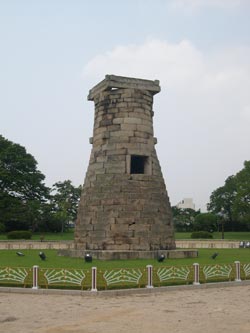
The Cheomseongdae observatory
By Michael Banks
Being the International Year of Astronomy, what better time than to go and see Asia’s oldest surviving observatory.
The Cheomseongdae (star-gazing tower) observatory in Gyeongyu, South Korea, dates back to the seventh century and was built during the reign of Queen Seondoek of Silla.
The Silla dynasty began in 57 BC and reigned for almost 1000 years. It was one of the three kingdoms that ruled in Korea, but by 660 AD it had occupied the other two kingdoms – Baekje and Goguryeo — to rule most of the Korean peninsula.
The observatory is around 9m high and is built by 356 stones representing each day in the year. Seemingly everything about the construction of the observatory has some meaning. The observatory has 27 layers of stones as it is thought that Queen Seondoek was Silla’s 27th ruler. Then, above and below the opening is 12 layers of stone for every month in the year.
The Queen’s astronomer would climb to the top of the observatory every day to take a view the sky. Using a ladder, he would clamber through the opening in the observatory and then climb to the top. There he would give information to the Queen about weather patterns and the timings of any solar eclipse.



